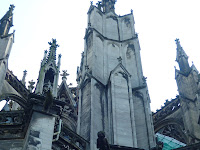 |
| One of the many references to Goethe's ginkgo |
One thing you have to face when going on a major trip like mine is the issue of what to leave off the itinerary. Sometimes the "triage" occurs at the planning stage, sometimes it happens when you first arrive and the scope of undertaking what you have on your wish list becomes obvious. But usually it hits later, after "stuff happens," that you cannot possibly cram everything on top of what you didn't foresee happening.
It could be a day later - after a return to a certain place is out of the question - or it could be (horrors) when you look at a travel guide and realize you didn't even know such-and-such a feature even existed: regrets set in.
I regret not seeing the botanical gardens in Berlin and elsewhere, but I'm not consumed by it. I realized, while there was still time, that seeing beautiful flowers from other countires mattered less to me than chancing upon flowers growing wild by the road. The poppy and armeria I plucked in Sachsenhausen, to press and preserve in a book, are more precious to me now than a memory of a strange orchid in a greenhouse (as lovely as that may have been).
I feel almost a guilty twinge for not looking for Goethe's ginkgo tree in Weimar, which was planted in the early 19th century. After all, he wrote a famous poem about it, and the poem seems to describe my character as much as his. http://www.wisdomportal.com/Poems2007/Goethe-Ginkgo.html But I can live with that. At least I saw the town, enjoyed its serenity, and saw the graveyard where he, Schiller, and the Goethe clan were buried (even if I couldn't find the great man's actual tomb!!).
But the greatest regret of all is failing to fufill a promise I made to myself and a dear friend, namely, that I would go to the Kumpfstichkabinet in Berlin's Kulturforum and examine some Dürer prints up close. I did go, but the special room was closed because it was Saturday. When we returned to Berlin, we didn't go back. And on the extra day we had, we went to Lübeck.
This and other regrets, small and large, become more painful when I think of how unlikely it is that I will ever be in Germany again. With that in mind, I should cherish what I did experience all the more. In life there are rarely second chances - and maybe the knowledge of that makes sweet experiences all the sweeter.
Carpe diem!












































